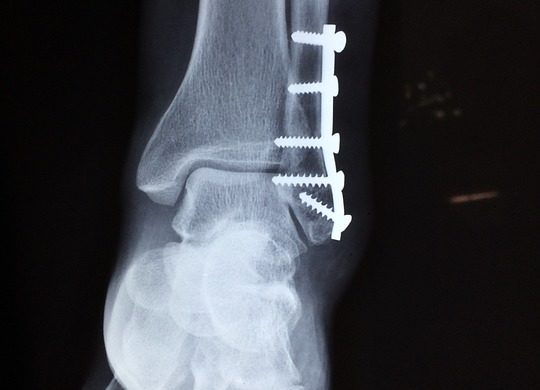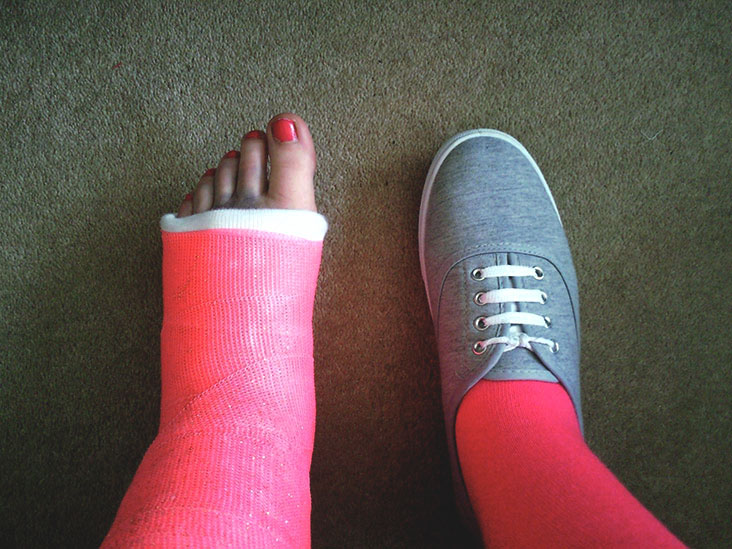A foot or ankle fracture, or other foot and ankle injury, is a common occurrence after an auto accident. Whether you have a case or not is dependent upon proof that someone other than yourself was at fault for the accident. If you can prove the ankle fracture and resulting treatment were caused by the accident, and if the at-fault party has auto insurance, or if you have uninsured or underinsured motorist coverage, then you may have a case for your treatment to be covered.
Finding Fault
If the other driver was clearly at fault for the accident, then you should be able to prove this fault through a police report and your own testimony. In some more significant cases where the expenses warrant it, your attorney may want to hire a company to reconstruct the accident visually and to help show how it happened and who was at fault. If no one contacted a police officer or if none ever arrived, you should report your accident to the police as soon as you can. You may also need to rely on any witnesses in this scenario, or the at-fault party’s own honesty, as well as your own testimony. In some instances, there may be traffic-cam video of your accident. If you are a passenger in a car, the at-fault party may be the person who was driving you, in which case you would have a claim against that person and not the driver of the other car.

Insurance
You will also need to know what kind of auto insurance you have – whether it is limited or full tort. Limited tort auto insurance is cheaper but prevents suits for pain and suffering damages unless you have a significant enough injury. An ankle fracture is likely to meet this threshold, but you should check on the type of insurance you have regardless. If you own a car but do not have auto insurance, you will automatically be considered limited tort and you can only get coverage for the medical treatment for your ankle fracture through your own health insurance.
Proving Your Injury
To prove you suffered harm from the auto accident you will have to prove that your ankle fracture, all treatment, and the resulting medical bills were related to the auto accident. While this may seem obvious; a report from a medical expert, such as your treating doctor, can be very helpful in showing this. This is especially helpful for proving what future issues you may have as a result of your ankle fracture: You could have limited mobility that could affect your work, the development of severe arthritis, the need for surgery or additional surgical treatment down the line if you already had initial surgery, etc. How severe of an injury you have can depend on the type and severity of the ankle fracture. Some very common ankle fractures are:
- Lateral malleolus fracture – a break of the lateral malleolus, the bone on the outside of the ankle joint. This bone is part of the fibula, one of two bones of the lower leg. You can see it as the bump on the outside of the ankle.
- Bimalleolar ankle fracture – breaks of both the lateral malleolus and of the medial malleolus or the end of the shin bone (tibia) that forms the support for the inner side of the ankle joint. The medial malleolus can be seen as the bump on the inside of the ankle in the lower portion of the tibia.
- Trimalleolar ankle fracture – breaks in three sides of the ankle: the medial malleolus of the tibia, as well as the lateral malleolus and posterior malleolus (the back of the tibia at the level of the ankle joint).
- Pilon fracture or plafond fracture – a fracture through the weight-bearing top of the ankle (the central portion of the lower tibia).

Covering Medical Bills
Your medical bills will initially be covered under the medical benefits you have with your auto policy. Once those are exhausted your health insurance will cover all bills. If your health insurance is a self-funded, ERISA plan, it will have a lien on any payments it covers for your medical treatment. This means the money will get paid back out of any settlement or verdict you get in your case on the bills it paid, and the lien will be included as medical bills owed as a result of your accident.
If you are unable to work as a result of your ankle fracture you will need to prove your wages through pay stubs and tax returns. If your inability to work is long term, your attorney may prove your wage loss through experts such as actuaries. You will also need the support of your doctors or other medical experts to prove your inability to work.
In some instances, your damages from your ankle fracture may exceed the insurance coverage of the at-fault party. In this case, if you have underinsured motorist coverage, you can claim your own auto insurance to collect those benefits. If the at-fault party has no auto insurance or did a hit and run, you can still make a recovery against your own insurance if you have uninsured motorist coverage.
Getting Help
The Thistle Law Firm is experienced at handling auto accident foot and ankle fracture claims. If you or a loved one suffered such an injury from a car crash, the attorneys at the Thistle Law Firm are here to take your call at 215-568-6800.

